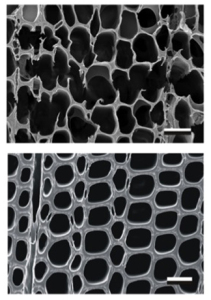
Scanning electron microscopy (SEM) image of pine that was substantially eroded by the white rot P. gigantea compared against a SEM of sound wood (bottom). Bar = 40 µm. (Image from Hori et al. PloS Genet. doi:10.1371/journal.pgen.1004759.g002)
Unlike many other white rot fungi, P. gigantea prefers to colonize freshly-harvested wood.
The Science:
Researchers sequenced and analyzed the white rot fungus Phlebiopsis gigantea, which can break down fresh-cut conifer sapwood. They also sequenced and analyzed the set of P. gigantea’s secreted proteins (secretome) and the set of all of its RNA molecules (transcriptome).
The Impact:
The analysis and annotation of the fungal genome, as well as its secretome and transcriptome provide insights into the mechanisms by which P. gigantea colonizes wood, as well as how the fungus contributes to the global carbon cycling processes.
Summary
For bioenergy researchers, fungi are interesting because they are capable of breaking down wood and leaf litter in forests and lawns. As plant biomass is a sustainable, alternative energy source the U.S. Department of Energy (DOE) is interested in developing, researchers are probing the fungal processes involved in breaking down and converting plants into sugars, information that they hope to harness at industrial-scale settings.
Researchers at the DOE Joint Genome Institute (JGI), a DOE Office of Science user facility, have been sequencing and analyzing two primary groups of fungi: brown rots and white rots. While both groups can break down the cellulose and hemicellulose in plant cell walls, only white rots can break down lignin as well. This difference, though seemingly slight, is the reason why one fungal genomics study in Science proposed that an ancestral white rot fungus may have ended the formation of coal deposits.
Many of the white rot fungal genomes sequenced and analyzed at DOE JGI are known to break down decaying wood. In a study published December 4, 2014 in PloS Genetics however, a consortium including DOE JGI researchers reported on the mechanisms by which the white rot fungus Phlebiopsis gigantea breaks down plant cell walls and resinous components in the freshly-cut sapwood of conifers. In one aspect of the study, researchers monitored the progress of the fungus on wafers of sapwood from aspen, pine and spruce over three months and compared these results against uninoculated wafers. In another experiment, they measured the fungus’ levels of gene expression in a scenario where glucose had been extracted from freshly-harvested pine wood using acetone, and a scenario where the glucose had not already been extracted from the freshly-harvested wood.
“The results advance understanding of the early and exclusive colonization of coniferous wood by P. gigantea and also provide a framework for developing effective wood protection strategies, improving biocontrol agents and identifying useful enzymes,” the team concluded.
Contact
Igor Grigoriev
DOE Joint Genome Institute
[email protected]
Funding
- U.S. Department of Energy Office of Science
- U.S. Department of Agriculture Cooperative State, Research, Education, and Extension Service
- Spanish Ministry of Economy and Competitiveness
- INDOX
- Chilean National Fund
Publication
Hori C et al. Analysis of the Phlebiopsis gigantea Genome, Transcriptome and Secretome Provides Insight into Its Pioneer Colonization Strategies of Wood. PLoS Genet. 2014 Dec 4. 10(12): e1004759. doi:10.1371/journal.pgen.100475